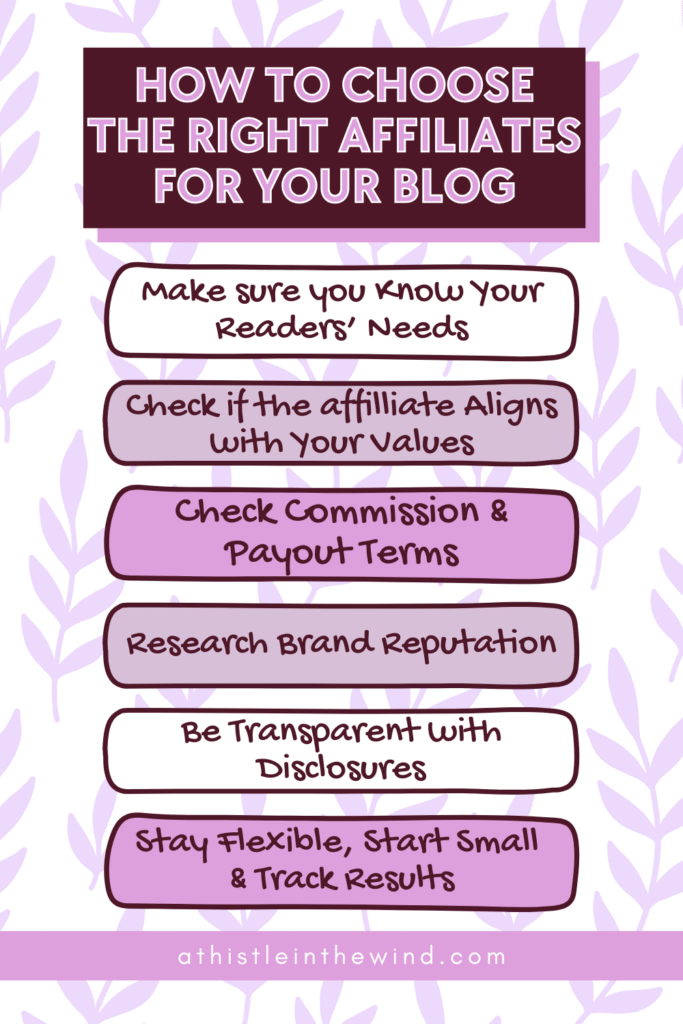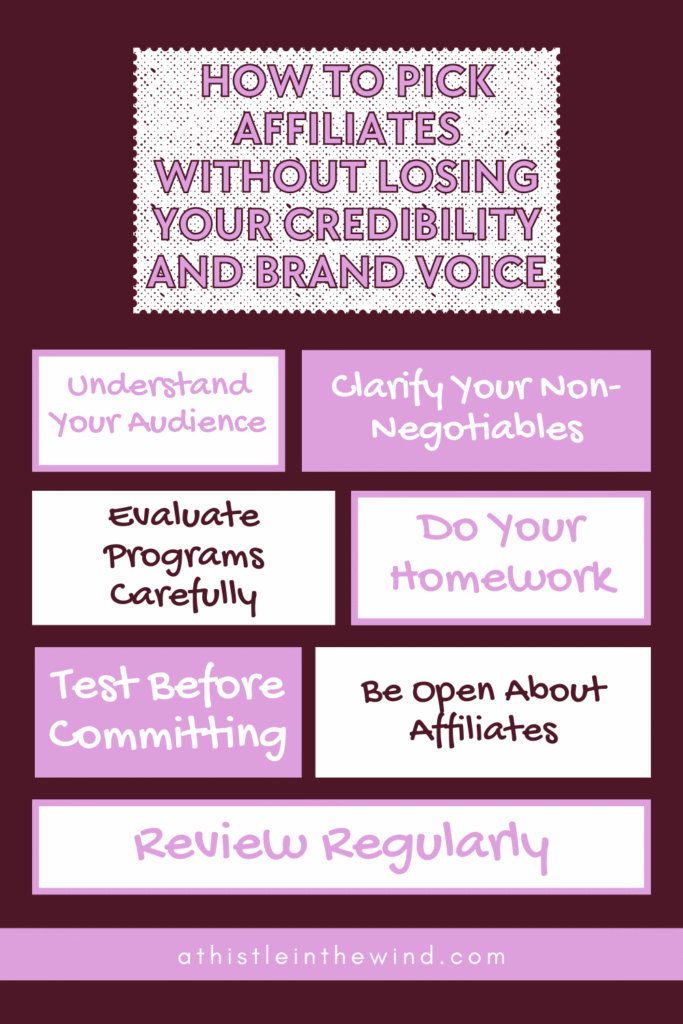How to Choose the Right Affiliates for Your Blog

Affiliate marketing has been called many things—some flattering, some…less so. At its best, it’s simply a way to share tools and products you genuinely believe in, and earn something in return.
Choosing the right affiliates isn’t about chasing the highest commission or slapping banners on every available inch of your site. It’s about finding partnerships that feel like an extension of your work, rather than a jarring detour.
If you’re considering adding—or refining—affiliate income streams, here are a few principles worth considering. Not rules, just guideposts that can help you avoid regret later.
Understand What Your Readers Actually Want
If you’ve been blogging for more than five minutes, you know that assumptions about your audience can lead you astray faster than a questionable link on Reddit.
Before you sign up for any affiliates, take a moment to think about what your readers consistently show up for. This isn’t always what you think it is. Sometimes the posts you feel lukewarm about end up becoming your most visited pages.
Consider:
- What problems do your readers come here hoping to solve?
- Are they mostly looking for how-to guides, or do they prefer broader inspiration?
- What have they responded to in the past—long guides, quick lists, personal recommendations?
- What price ranges are actually realistic for them?
If your audience is primarily early-career freelancers or students, a $2,000 luxury software suite probably isn’t going to resonate—no matter how generous the affiliate payout. You’ll get more traction (and feel better) recommending something that feels accessible and necessary.
Sometimes it helps to look at your analytics and see which posts people spend time on, and what they click when they get there. It’s a small clue about what they trust you to help them with.
Get Clear on Your Blog’s Values
It sounds lofty, but clarity here is what will save you a lot of regret later. Some blogs are driven by a desire to democratize information. Others are about curating the best of everything, regardless of price. Some prioritize sustainability or minimalism.
Ask yourself:
- What’s non-negotiable for me?
- Do I want my recommendations to feel accessible to most people, or is my blog intentionally niche?
- How do I want readers to feel about the products and services I suggest?
When you know your own red lines, it’s easier to evaluate potential partners without getting swept up in shiny promises.
If you care about transparency, an affiliate that buries the true cost of their service behind upsells probably isn’t a good fit, no matter how high the commissions.
If you’re building a brand around careful curation, you’ll want to avoid recommending tools you’ve never tried yourself.
And if you’re not sure what your values are, you can think about the content you most enjoyed creating. Often, that’s where your actual standards live.
Evaluate Affiliates with a Level Head
Not all affiliate programs are created equal. Some are well-run, with transparent policies and reliable payouts. Others are more opaque, or even opportunistic.
It helps to look at a few things before you join:
1. Commission Structure
Is it flat-rate or percentage-based? Does it reward repeat business? Sometimes the “highest commission” is attached to something your readers are unlikely to buy.
2. Cookie Duration
This is the length of time after someone clicks your link that you still get credit for the sale. Longer cookies are helpful if your audience likes to take their time deciding.
3. Payout Threshold
Some programs won’t pay out until you hit a minimum earnings amount. Make sure the threshold is realistic for the size of your audience.
4. Brand Reputation
What are real customers saying? A quick look through independent reviews can reveal patterns you won’t see on the brand’s website.
5. Support
Some programs offer marketing materials, training, and dedicated account managers. Others leave you to figure it out on your own. Decide what you’re comfortable with.
None of these factors alone are a deal-breaker, but together, they paint a picture of whether the relationship will be worth your energy.
You might also consider working with smaller or newer companies. In my experience, they’re often more responsive to questions and open to building genuine partnerships. It can be easier to do your own due diligence when you’re not dealing with a giant program that treats affiliates as faceless traffic sources. Just make sure you understand their payment terms and look for early feedback from other customers.

Start Small and Observe
Affiliate marketing has a way of tempting you to dive in all at once—especially if you’re the type who likes everything neatly sorted from day one. But it’s usually better to start small.
Try adding a single affiliate link to a post that already gets steady traffic. See what happens over a few weeks. Pay attention to:
- How many clicks you’re getting
- If people ask you questions or share feedback
- If any unsubscribes or complaints come in
Use whatever tracking tools your affiliate program provides, but also rely on your gut sense of whether the product feels like a natural fit.
This isn’t a race. When you treat it like a series of small experiments, you’ll make clearer decisions about what belongs in your content.
Disclose Transparently (and Confidently)
There’s no polite way to say this: burying disclosures is both legally dubious and a fast track to eroding trust. Clear disclosure doesn’t cheapen your recommendations—it makes them credible.
A simple statement is usually enough. It can be like this:
“This post contains affiliate links, which means I may earn a commission if you make a purchase.”
Your readers appreciate knowing the context. It shows you respect their ability to make informed choices. I’ve noticed that transparency often improves conversions over time. People trust you more when you don’t pretend everything you recommend is purely altruistic.
Full disclosure: right now, the only active affiliate program I’m signed on to is WP Rocket. I had a Notion affiliate link but I didn’t continue with it because I wasn’t really doing anything Notion related here.
If you’re interested in learning more about how I use WP Rocket, check out my blog: How to Improve Your Website Speed and Performance with WP Rocket.
Prioritize Fit Over Payout
It’s easy to fall for the allure of higher commissions. But in the long run, the most sustainable affiliate relationships are the ones that feel like a natural extension of what you already do. Ask yourself:
- Would I recommend this even if I didn’t earn anything?
- Does this product genuinely help my readers?
- Will I feel comfortable answering questions about it honestly?
If the answer to any of these is no, you’ll probably regret including it later—especially if a reader has a bad experience.
Remember, your credibility isn’t renewable. Once you lose it, it’s hard to get back.
Be Prepared to Reassess
Sometimes, an affiliate partnership feels promising at first but doesn’t pan out. Or maybe the company changes policies, gets acquired, or quietly shifts how they operate. It’s fine to step away.
One of the advantages of being an independent creator is that you’re not locked into someone else’s agenda. If something stops working for you or your readers, you can revise your approach.
Think of it like pruning a plant. Occasionally, you need to cut back what isn’t thriving to make space for something that might.
Think Long-Term
Sustainable affiliate income isn’t about quick wins. It’s about showing up consistently, recommending products that feel aligned with your work, and giving your audience time to trust you.
When you demonstrate that you care about their experience—not just your own revenue—people notice. Over time, a good affiliate strategy feels less like selling and more like sharing.
In the End, Do It Your Way
Choosing affiliates is part strategy, part instinct. You don’t have to get it perfect the first time. You don’t have to vet every company as though your life depends on it. But you do owe it to yourself—and your audience—to pick partnerships that feel aligned with the work you’re already proud to share. If you start there, the rest usually falls into place. And if it doesn’t? You can always adjust.

